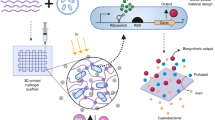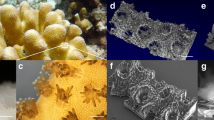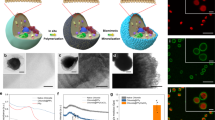Abstract
The rewiring of photosynthetic biomachineries to electrodes is a forward-looking semi-artificial route for sustainable bio-electricity and fuel generation. Currently, it is unclear how the electrode and biomaterial interface can be designed to meet the complex requirements for high biophotoelectrochemical performance. Here we developed an aerosol jet printing method for generating hierarchical electrode structures using indium tin oxide nanoparticles. We printed libraries of micropillar array electrodes varying in height and submicrometre surface features, and studied the energy/electron transfer processes across the bio-electrode interfaces. When wired to the cyanobacterium Synechocystis sp. PCC 6803, micropillar array electrodes with microbranches exhibited favourable biocatalyst loading, light utilization and electron flux output, ultimately almost doubling the photocurrent of state-of-the-art porous structures of the same height. When the micropillars’ heights were increased to 600 µm, milestone mediated photocurrent densities of 245 µA cm–2 (the closest thus far to theoretical predictions) and external quantum efficiencies of up to 29% could be reached. This study demonstrates how bio-energy from photosynthesis could be more efficiently harnessed in the future and provide new tools for three-dimensional electrode design.
This is a preview of subscription content, access via your institution
Access options
Access Nature and 54 other Nature Portfolio journals
Get Nature+, our best-value online-access subscription
$29.99 / 30 days
cancel any time
Subscribe to this journal
Receive 12 print issues and online access
$259.00 per year
only $21.58 per issue
Buy this article
- Purchase on Springer Link
- Instant access to full article PDF
Prices may be subject to local taxes which are calculated during checkout





Similar content being viewed by others
Data availability
All data used in this paper are available via the Apollo repository (https://doi.org/10.17863/CAM.80096) or on GitHub (https://github.com/JLawrence96/MicropillarArrayElectrodes).
Code availability
All code used in this paper are available via the Apollo respository (https://doi.org/10.17863/CAM.80096) or on GitHub (https://github.com/JLawrence96/MicropillarArrayElectrodes).
References
Kornienko, N., Zhang, J. Z., Sakimoto, K. K., Yang, P. D. & Reisner, E. Interfacing nature’s catalytic machinery with synthetic materials for semi-artificial photosynthesis. Nat. Nanotechnol. 13, 890–899 (2018).
Zhang, J. Z. & Reisner, E. Advancing photosystem II photoelectrochemistry for semi-artificial photosynthesis. Nat. Rev. Chem. 4, 6–21 (2020).
King, P. W. Semi-synthetic strategy. Nat. Energy 3, 921–922 (2018).
Léger, C. & Bertrand, P. Direct electrochemistry of redox enzymes as a tool for mechanistic studies. Chem. Rev. 108, 2379–2438 (2008).
Saar, K. L. et al. Enhancing power density of biophotovoltaics by decoupling storage and power delivery. Nat. Energy 3, 75–81 (2018).
Wey, L. T. et al. The development of biophotovoltaic systems for power generation and biological analysis. ChemElectroChem 6, 5375–5386 (2019).
Zhang, J. Z. et al. Photoelectrochemistry of photosystem II in vitro vs in vivo. J. Am. Chem. Soc. 140, 6–9 (2018).
McCormick, A. J. et al. Biophotovoltaics: oxygenic photosynthetic organisms in the world of bioelectrochemical systems. Energy Environ. Sci. 8, 1092–1109 (2015).
Bradley, R. W., Bombelli, P., Lea-Smith, D. J. & Howe, C. J. Terminal oxidase mutants of the cyanobacterium Synechocystis sp. PCC 6803 show increased electrogenic activity in biological photo-voltaic systems. Phys. Chem. Chem. Phys. 15, 13611–13618 (2013).
Sekar, N., Jain, R., Yan, Y. & Ramasamy, R. P. Enhanced photo-bioelectrochemical energy conversion by genetically engineered cyanobacteria. Biotechnol. Bioeng. 113, 675–679 (2016).
Liu, C., Dasgupta, N. P. & Yang, P. Semiconductor nanowires for artificial photosynthesis. Chem. Mater. 26, 415–422 (2014).
Mersch, D. et al. Wiring of photosystem II to hydrogenase for photoelectrochemical water splitting. J. Am. Chem. Soc. 137, 8541–8549 (2015).
Wijnhoven, J. E. & Vos, W. L. Preparation of photonic crystals made of air spheres in titania. Science 281, 802–804 (1998).
Liu, Y. et al. Macroporous indium tin oxide electrode layers as conducting substrates for immobilization of bulky electroactive guests. Electrochim. Acta 140, 108–115 (2014).
Riedel, M. & Lisdat, F. Integration of enzymes in polyaniline-sensitized 3D inverse opal TiO2 architectures for light-driven biocatalysis and light-to-current conversion. ACS Appl. Mater. Interfaces 10, 267–277 (2018).
Xia, L. et al. Zinc oxide inverse opal electrodes modified by glucose oxidase for electrochemical and photoelectrochemical biosensor. Biosens. Bioelectron. 59, 350–357 (2014).
Arsenault, E., Soheilnia, N. & Ozin, G. A. Periodic macroporous nanocrystalline antimony-doped tin oxide electrode. ACS Nano 5, 2984–2988 (2011).
Wenzel, T., Härtter, D., Bombelli, P., Howe, C. J. & Steiner, U. Porous translucent electrodes enhance current generation from photosynthetic biofilms. Nat. Commun. 9, 1299 (2018).
Fang, X., Kalathil, S., Divitini, G., Wang, Q. & Reisner, E. A three-dimensional hybrid electrode with electroactive microbes for efficient electrogenesis and chemical synthesis. Proc. Natl Acad. Sci. USA 117, 5074–5080 (2020).
Sturmberg, B. C. P. et al. Modal analysis of enhanced absorption in silicon nanowire arrays. Opt. Express 19, A1067–A1081 (2011).
Ali, M. et al. Nanostructured photoelectrochemical solar cell for nitrogen reduction using plasmon-enhanced black silicon. Nat. Commun. 7, 11335 (2016).
Wang, K., Chang, Y.-H., Zhang, C. & Wang, B. Conductive-on-demand: tailorable polyimide/carbon nanotube nanocomposite thin film by dual-material aerosol jet printing. Carbon 98, 397–403 (2016).
Saleh, M. S., Li, J., Park, J. & Panat, R. 3D printed hierarchically-porous microlattice electrode materials for exceptionally high specific capacity and areal capacity lithium ion batteries. Addit. Manuf. 23, 70–78 (2018).
Saleh, M. S., Hu, C. & Panat, R. Three-dimensional microarchitected materials and devices using nanoparticle assembly by pointwise spatial printing. Sci. Adv. 3, e1601986 (2017).
Ćatić, N. et al. Aerosol-jet printing facilitates the rapid prototyping of microfluidic devices with versatile geometries and precise channel functionalization. Appl. Mater. Today 19, 100618 (2020).
Jabari, E. & Toyserkani, E. Micro-scale aerosol-jet printing of graphene interconnects. Carbon 91, 321–329 (2015).
Sukeshini, A. M. et al. Aerosol jet printing and microstructure of SOFC electrolyte and cathode layers. ECS Trans. 35, 2151 (2011).
Kalio, A. et al. Development of lead-free silver ink for front contact metallization. Sol. Energy Mater. Sol. Cells 106, 51–54 (2012).
Lu, S. et al. Flexible, print-in-place 1D–2D thin-film transistors using aerosol jet printing. ACS Nano 13, 11263–11272 (2019).
Hong, K. et al. Aerosol jet printed, sub-2 V complementary circuits constructed from P- and N-type electrolyte gated transistors. Adv. Mater. 26, 7032–7037 (2014).
Lin, J.-T. et al. A high-efficiency HIT solar cell with pillar texturing. IEEE J. Photovolt. 8, 669–675 (2018).
Saini, D. K., Pabbi, S. & Shukla, P. Cyanobacterial pigments: perspectives and biotechnological approaches. Food Chem. Toxicol. 120, 616–624 (2018).
Wey, L. T. et al. A biophotoelectrochemical approach to unravelling the role of cyanobacterial cell structures in exoelectrogenesis. Electrochim. Acta 395, 139214 (2021).
Clifford, E. R. et al. Phenazines as model low-midpoint potential electron shuttles for photosynthetic bioelectrochemical systems. Chem. Sci. 12, 3328–3338 (2021).
Torimura, M., Miki, A., Wadano, A., Kano, K. & Ikeda, T. Electrochemical investigation of cyanobacteria Synechococcus sp. PCC7942-catalyzed photoreduction of exogenous quinones and photoelectrochemical oxidation of water. J. Electroanal. Chem. 496, 21–28 (2001).
Reggente, M., Politi, S., Antonucci, A., Tamburri, E. & Boghossian, A. A. Design of optimized PEDOT-based electrodes for enhancing performance of living photovoltaics based on phototropic bacteria. Adv. Mater. Technol. 5, 1900931 (2020).
Cereda, A. et al. A bioelectrochemical approach to characterize extracellular electron transfer by Synechocystis sp. PCC6803. PLoS ONE 9, e91484 (2014).
Zeng, Y. et al. Photoactive conjugated polymer-based hybrid biosystems for enhancing cyanobacterial photosynthesis and regulating redox state of protein. Adv. Funct. Mater. 31, 2007814 (2021).
Stanier, R. Y., Kunisawa, R., Mandel, M. & Cohen-Bazire, G. Purification and properties of unicellular blue-green algae (order Chroococcales). Bacteriol. Rev. 35, 171–205 (1971).
Lea-Smith, D. J. et al. Thylakoid terminal oxidases are essential for the cyanobacterium Synechocystis sp. PCC 6803 to survive rapidly changing light intensities. Plant Physiol. 162, 484–495 (2013).
Yang, C., Zhou, E., Miyanishi, S., Hashimoto, K. & Tajima, K. Preparation of active layers in polymer solar cells by aerosol jet printing. ACS Appl. Mater. Interfaces 3, 4053–4058 (2011).
Fang, X. et al. Structure–activity relationships of hierarchical three-dimensional electrodes with photosystem II for semiartificial photosynthesis. Nano Lett. 19, 1844–1850 (2019).
R Core Team R: A Language and Environment for Statistical Computing (R Foundation for Statistical Computing, 2013).
Wei, T. & Simko, V. corrplot: visualization of a correlation matrix. R package version 0.84 https://github.com/taiyun/corrplot (2017).
Acknowledgements
This work was supported by the Biotechnology and Biological Sciences Research Council (BB/M011194/1 to J.M.L., BB/R011923/1 to J.Z. and X.C.), the Cambridge Trust (L.T.W.) and the Isaac Newton Trust (SCHERTEL SNSF3 to L.S.). S.K.-N. is grateful for support from a European Research Council (ERC) Starting Grant (ERC-2014-STG-639526, NANOGEN). S.K.-N. and Q.J. acknowledge support from the EPSRC Centre of Advanced Materials for Integrated Energy Systems (CAM-IES) (grant EP/P007767/1). We thank H. Lloyd-Laney and E. Kitson for helpful discussions in statistical analysis. We thank N. Plumeré and H. Li for helpful discussions in electrochemistry. We thank P. J. Bártolo and F. Liu for helpful discussions in 3D bioprinting.
Author information
Authors and Affiliations
Contributions
J.Z.Z. and X.C. conceived the project and wrote the manuscript. X.C. was the lead experimenter, interpreted the data and produced Figs. 1–4. J.M.L. helped with the preparation of the manuscript, performed and interpreted the statistical analysis, and produced Fig. 5b. L.T.W. provided biological samples and expertise. L.S. helped to design and carry out and interpret the light transmission/reflection/absorption experiments. Q.J. helped to establish the initial protocol for aerosol jet printing pillars. S.V. helped guide the light experiments. C.J.H. contributed biological expertise and samples. S.K.-N. helped to guide the initial printing experiments. All contributed comments to the manuscript.
Corresponding author
Ethics declarations
Competing interests
The authors declare no competing interests.
Peer review
Peer review information
Nature Materials thanks Lars Jeuken and the other, anonymous, reviewer(s) for their contribution to the peer review of this work.
Additional information
Publisher’s note Springer Nature remains neutral with regard to jurisdictional claims in published maps and institutional affiliations.
Supplementary information
Supplementary Information
Supplementary Notes 1–4, Figs. 1–16 and Tables 1–3.
Rights and permissions
About this article
Cite this article
Chen, X., Lawrence, J.M., Wey, L.T. et al. 3D-printed hierarchical pillar array electrodes for high-performance semi-artificial photosynthesis. Nat. Mater. 21, 811–818 (2022). https://doi.org/10.1038/s41563-022-01205-5
Received:
Accepted:
Published:
Issue Date:
DOI: https://doi.org/10.1038/s41563-022-01205-5
This article is cited by
-
Polydopamine-coated photoautotrophic bacteria for improving extracellular electron transfer in living photovoltaics
Nano Research (2024)
-
Protein film electrochemistry
Nature Reviews Methods Primers (2023)
-
Rewiring photosynthetic electron transport chains for solar energy conversion
Nature Reviews Bioengineering (2023)
-
A Generalized Polymer Precursor Ink Design for 3D Printing of Functional Metal Oxides
Nano-Micro Letters (2023)
-
Progress in the application of 3D printing technology in ophthalmology
Graefe's Archive for Clinical and Experimental Ophthalmology (2023)



